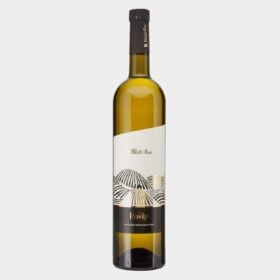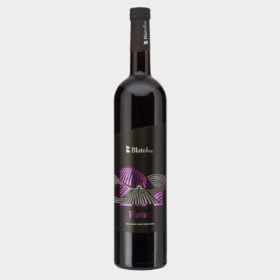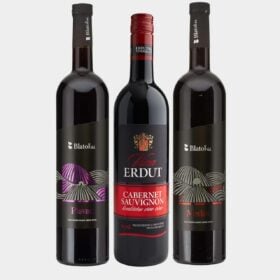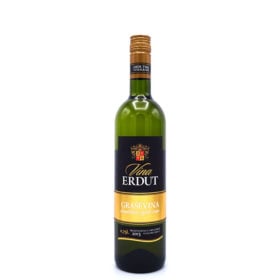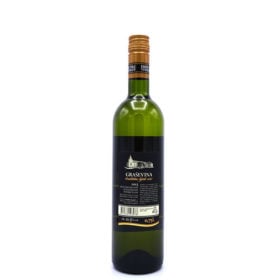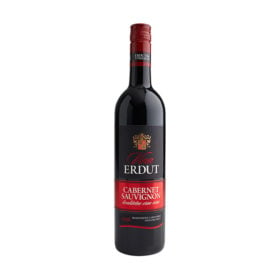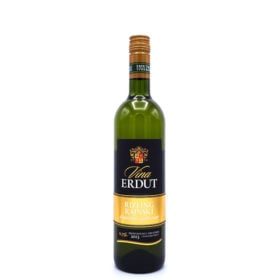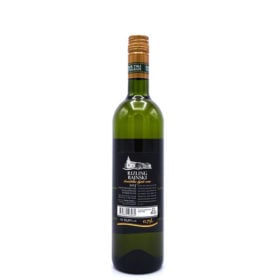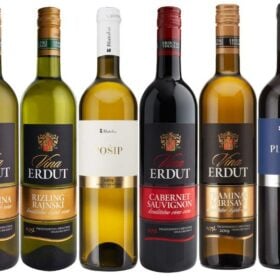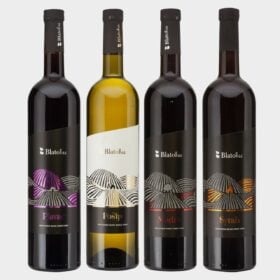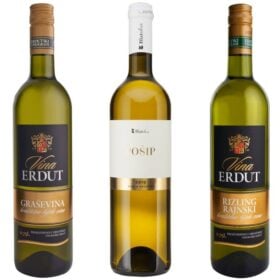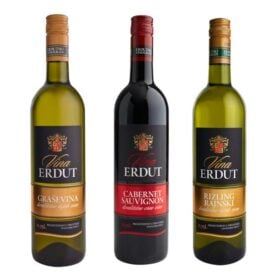Wine from Dalmatia and its sub-regions
Wine has been made in southern Croatia for centuries. The wine from Dalmatia is known for its top quality. In addition, the wine from Dalmatia is also known for its special varieties such as the Posip, Plavac Mali (dingac), Crljenak, Babić en Merlot. In addition to wine, there is also a lot olive oil produced in Dalamtia.
Northern Dalmatia, Central and Southern Dalmatia, as well as Dalmatian Zagora (the hinterland of Dalamtia) are the four major sub-regions in Dalmatia. Vineyards in Northern Dalmatia are far from the coast. An exception to this are the wine hills of Primošten. Wine from northern Dalmatia is therefore crispier compared to wine from the far south of Croatia. Nevertheless, the wine from this northern Dalmatian region does not have the characteristics that belong to a continental climate. This is the case for wine from the Dalmatian Zagora (the hinterland of Dalmatia).

typical White wine from Dalmatia
- Posip (pronounced po-ship)
- Maraština (pronounce: ma-rash-ti-na)
- Bogdanuša (pronounced: bog-da-noe-sha)
- Cetinka (pronounced: tse-tin-ka)
- Debit (pronounce: de-bit)
- Grk Bijeli (pronounce: grk bie-je-lie)
- Vugava (pronounce: wu-ga-wa)
typical Red wine from Dalmatia
- Plavac mali (pronounced: pla-wats ma-lie)
- Babić (pronounced: ba-bie-ch)
- Merlot (pronounced mer-low)
The wine regions in Dalmatia
Wine from Central and Southern Dalmatia
Central and Southern Dalmatia are two typical Mediterranean regions. In these regions, wine is made almost exclusively from grapes of local origin. Centuries of adaptation to the climate and soil allow them to thrive on the sunny slopes overlooking the sea.
Historically, Dalmatian Zagora was more locally oriented and conducted most of its trading activities with Bosnia and Herzegovina, while the coastal region of Dalmatia exported its wines to several European countries. That is why these three sub-regions offer a great diversity of wine.
Red wine from Dalmatia
Red wines from the like the Rhône Syrah and the Grenache Noir were domesticated very successfully in northern Dalmatia. This sub-region not only provided an excellent environment for local grape variety Plavina, but also for grapes such as white Debit en Maraština.
Wine from the Dalmatian hinterland
Dalmatian Zagora, is dominated by the local grape variety de Kujundžuša. This grape variety gives mild and soft wines. The Kujundžuša grapes account for about 90% of the total wine production in the Imotski area.
Wine from the coastal region of Dalmatia
The coastal region, on the other hand, offers an excellent environment for red wines as Plavac mali, Babić, and Crljenak. One of the best White wine in Croatia, for example the Posip, come from the island Korcula.
- Original price was: €19,98.€ 13,99Current price is: €13,99. Add to Cart
Wine package as a test package
Original price was: €42,99.€ 34,99Current price is: €34,99. Add to Cart
Wine from South Dalmatia
As in other Dalmatian regions, viticulture and wine production were introduced to the area by the ancient Greeks. The most prominent centers at that time were the Greek settlements of Cavtat (Epidaurus) and Korcula (Korkyra). That long tradition of viticulture in the region has been preserved almost continuously in the areas to this day Korcula en Peljesac. However, due to tumultuous historical events and the influence of the Ottoman Empire, the coastal region has suffered significant damage.
During those difficult times, the Dubrovnik Republic played the most prominent role in preserving viticulture. Viticulture was highly regarded by the citizens. Those historic events have contributed to the development and preservation of many local wines, most of which are currently made in this area.
The climate in this region is typically Mediterranean despite being noticeably more humid and slightly cooler compared to the islands of central Dalmatia. Therefore, wines from the region show remarkable stylistic differences compared to Central Dalmatia, even if they are the same grape varieties, such as the Plavac mali of Maraština.
Plavac mali en Maraština wine
Plavac mali en Maraština (locally also called Rukatac), are the region's most prominent wine varieties. Plavac mali grape has two very different types. One of them, grown in superior locations, such as Dingach and Postup, differs from grapes grown in the area of Peljesac and the hinterland of southern Dalmatia. The former, with its full-bodied, strong taste and stable characteristics, can compete with some of the most prominent international wines.
The latter, which are light and fruity, seem to belong to a very different breed. The microclimate, characteristic of Peljesac inland, is one of the reasons for such a difference. Because of the significant height difference in the hills and the high gradient above sea level, the peninsula is called Peljesac a number of characteristics of a continental climate, such as typically cold nights, early spring frosts and a lower degree of exposure to solar rays, especially during the spring and autumn.
As a Plavac mali To achieve the best results, grapes should not be grown on very fertile soil. The central part of Peljesac, with its fertile and fertile soil, is therefore not the most suitable location for growing Plavac Mali.
Wine out Peljesac, like the Dingach wine
When comparing wine from the region Peljesac with other Croatian regions it is interesting that many of the specific grape varieties are only used for lower quality wines.
That while the top quality wine out Peljesac is often only grown in specific locations, such as as Dingach, Postup and Žuljana. Therefore, it is common for one and the same winemaker to produce wines of different quality depending on the type and location of the vineyards. Despite the lower quality varieties from the interior of Peljesac, however, this region is still a leading producer of red wines top quality. That's why Plavac mali most certainly the leading grape variety of southern Dalmatia.
Maraština wine of 'balance'
Maraština is considered a grape of a much more balanced origin. This grape variety does not require a specific environment and is well adapted to different conditions. It can be found all along the Dalmatian coast, even in the northern region around the island of Cres and is extremely popular in southern Dalmatia, especially on the islands of Lastovo and Korcula and in the Konavle region. It is distinguished by a very good absorption of sugar and is used in the production of semi-strength, crisp wines.
Posip wine is one of the best known from southern Dalmatia
Posip, Grk and Malvasia around Dubrovnik are considered top quality white varieties. Posip is a wine of exceptional potential, whose market quality has long been known. That is why the Posip wine is increasingly produced.
Posip grape comes from the island Korcula, it is still the largest wine on the island. As a hybrid of Bratkovina en Zlatarica, is becoming Posip characterized by a high sugar content of up to 25 grams per litre, specific extract and a solid acidity.
Posip grape gives a powerful, full-bodied but still refreshing wine of pleasant taste. Next Chardonnay and the Istrian Malvasia this is the only white grape variety whose fermentation in barrique barrels does not cloud and retains its original taste.
grk and Malvasia wine
The fact that Grk and Malvasia are limited to specific growing areas does not affect their quality. Grk is a species that is excellently adapted to sandy soils around the island's town of Lumbarda Korcula. Malvasia looks much more like the Mediterranean kind, despite being isolated from the rest of the area around Korcula.
Grk reflects the Mediterranean temperament at its best when served as a dry, bitter, powerful wine with a strong flavor profile, while the Malvasia-characteristics are most noticeable when the grapes are well dried and the wine as if sweet is served.
White wine from South Dalmatia
- Posip (pronounced po-ship)
- grk (pronounced gr-k)
- Malvasija dubrovačka (pronounced: mal-wa-see-ja do-bro-watch-ka)
- Maraština or Rukatac (pronounced ma-ra-shti-na; ru-ka-tats)
Red wine from South Dalmatia
- Plavac mali (pronounced: pla-wats ma-lie)
- Merlot (pronounced mer-low)
Prominent Wine Regions in Southern Dalmatia
- the hills of Korcula (pronounced: ie-mot-ski)
- the hills of Peljesac (pronounced: wr-go-rats)
- the hills of Konvale (pronounced: wr-go-rats)
Wine from Central Dalmatia
The precise origins of Croatian viticulture and wine production originally began in this sub-region. Or the first vine exactly planted in Central Dalmatia remains a mystery. However, the ancient Greek settlements on the islands of Vis and Brač acquired their reputation at a very early stage, which gives these two islands the right to be the cradle of Croatian viticulture.
Coins depicting grapes and cups as well as countless archaeological finds related to wine consumption prove that viticulture was of the utmost importance to the local population. Viticulture quickly spread throughout the region and remained one of the most important aspects of agriculture. At the time of ancient Rome, its importance increased rapidly. Even the first Slavic peoples who settled in Croatia converted from mead (honey wine) to wine quite easily.
The whole region is dominated by fairly similar soil types and climatic conditions. With little precipitation and very hot dry summers, the climate is typically Mediterranean. The soil is often rich in limestone, which is covered by various types of red and brown soil.
Wine from Hvar
Characteristics of individual specific spots are more important for good growth of the grapes than a general soil type. One of these places are the Ivan Dolac and Sveta Nedjelja on the island of Hvar. Both are located on slopes near the sea and are well exposed to the sun's rays. The sea prevents too great a temperature change and is therefore an important stabilizing factor. The wind from the sea is essential for good air circulation in the vineyards.
The grapes have adapted to the area over the centuries and are often small. Thanks to the thin layer of fertile soil above the limestone, it is possible for the grapes to survive without human intervention.
Grape varieties from Central Dalmatia
The most prominent local grape variety is the Plavac mali. Traditionally, the best bunches of grapes came from the island of Hvar. However, the situation has recently changed slightly in favor of the islands Korcula, Brac and Vis. While this particular grape variety often lacks enough acidity, its extract is significantly richer the more readily the sugar levels accumulate. Hence, the wines easily reach an alcohol content of 15%.
Wines produced from Plavac mali grape simply have a wonderful and very different taste that makes them easy to distinguish. They are often characterized with a certain level of sweetness, especially in the aftertaste.
This sweetness is present for several reasons, the first being a specific ratio of high alcohol content, which, like any other strong alcoholic drink, creates an illusion of sweetness. Second contains Plavac mali a specific type tannin which, together with a very small sugar residue, creates a specific, sweet taste. The Plavac mali grape gives, just like the Babić, a large amount of grapes. This is especially the case when planted in karst fields.
Vugava wine
Vugava is another grape variety that is of great importance to this region. Although this very famous White wine has a long history, today it can only be found on the island of Vis, but in insufficient quantities.
Vugava wine was very popular due to its easy accumulation of sugar levels and high alcohol content. The latter is an excellent natural preservative by which Vugava wine could be transported over long distances thanks to its longer shelf life.
Because these characteristics are no longer sought after in wine, the Vugava wine lost popularity while light wines have become increasingly important. Full-bodied isn't the only benefit of the Vugava grape. The wine of this variety also has a refined taste and a thick, rich extract. Therefore it is expected Vugava will regain one of the leading positions in the future.
Forgotten grape varieties
This region has many other local wine varieties to offer that can also be considered distinctive. They are usually produced in small areas and have been modified for centuries to provide better quality. Unfortunately, due to a 'trendy' wine market, their future is not particularly bright.
A good example is the Dobričić grape variety from the island of Šolta, which is currently grown in small quantities and sold as table wine. On the open market it can only be found as a 'coupage' with Plavac mali or Plavina. Its main role is to enhance color as it is abundant in antioxidants.
It has been proven that Crljenak, produced in Kašteli, is of the same variety as Zinfandel. Special white grape varieties such as the Bogdanuša and Prč, as well as the red Drnekuša are mostly produced on the island of Hvar. Their time is yet to come, even if large vineyard areas are planted with Plavac mali grape.
Zlatarica, a neglected white variety of exceptional quality, is produced near the cities of Split and Omiš. The vines of this variety can be harvested on a regular basis and its grapes are known for their... sugars store well as well as preserving acids. Despite the fact that it has excellent properties, as in Posip, this grape is now only used as an additive to other wines.
White wine from Central Dalmatia
- Vugava (pronounce: wu-ga-wa)
Red wine from Central Dalmatia
- Plavac mali (pronounced: pla-wats ma-lie)
Prominent Wine Areas in Central Dalmatia
- the hills of Hvar (pronounced: h-where)
- the hills of Vis (pronounced: wies)
Wine from Northern Dalmatia
Northern Dalmatia covers a large geographical area with different climatic conditions. However, the same types of grapes are grown throughout the region. Being of the white species Maraština en Debit the most prominent, while the most typical red species would be Plavina, followed by Babić, lasina, Merlot, Syrah and Grenache.
Contrary to all expectations, both white and red wines from the region rich in acids. This interesting fact leads to the familiar landscape with great heat and strong winds.
Rather than producing full-bodied wines with a high tannin content, Northern Dalmatia offers wines that are predominantly firm, light, smooth and mellow, such as Plavina. White grape varieties from this sub-region are very similar in flavor profile. They are usually of a firm and smooth taste, typical of the region.
However, Northern Dalmatia offers a number of different varieties, which are not great in yield in quantity but are still of considerable importance. This relates specifically to certain wine regions, such as Primošten vineyards, famous for the Babić grapes, as well as regions of Promina and Oklaj, famous for their Debet grapes.
Babić grapes and Babić wine
Babić is a local species of Northern Dalmatian origin. The name can be directly related to the island of Pag or the Šibenik region.
As with some species of the Plavac mali produces the Babić wines of medium quality when the grapes are grown on the rich soil in the coastal region. Babić however, achieves best results when grown in coarse rocky areas and exposed to a lot of sun.
De Babić wine excellently retains acid levels. These acid levels reduce the strong influence of alcohol. The high levels of tannin and rich extracts give the Babić wine are distinctive and delicious taste. Therefore, this particular Croatian grape variety gives very good results when ripening in oak barrels. after all, it contributes to the taste and tames the tannins.
Babić top quality wine (quality wine) is becoming more and more popular. hence Babić, is one of the leading grape varieties of Northern Dalmatia.
Debit grape and Debit wine
Debet is another Northern Dalmatian grape variety that could become extremely popular at the national level in the future.
Although its potential has not yet been fully discovered, several very good wines of different styles show the multifaceted characteristics of this grape. The thick grapes, the relatively high acidity and the good ability to sugar to collect, make this strain a very suitable candidate for the production of dry, sweet wines, such as sparkling wines like the prosecco.
Due to the rich extract, the Debit large quantities of wine. This makes the Debet wines suitable for both aging in barrels and yeast sediments. The flavor profile of the Debet is known for its harmonious and refreshing primary taste minerals and citrus fruits.
International grape varieties in Northern Dalmatia
International species are well domesticated in the northern parts of the region. Merlot has been cultivated for several years in the Zadar, Benkovac and Stankovci regions. Cabernet Sauvignon is a relatively new variety, while Syrah, Grenache and Cinsault have been present in the region for more than three decades.
The grapes originally from the Southern Rhone have also adapted well to this sub-region and show comparable quality to the home region. Therefore, it is not surprising that the Rhone grapes also produce top quality wine in this region.
White wine from Northern Dalmatia
- Debit (pronounced de-beet)
- Maraština (pronounce: ma-rash-tie-na)
Red wine from Northern Dalmatia
- Babić (pronounced: ba-bietj)
- Syrah
- Grenache
Prominent Wine Regions in Northern Dalmatia
- the hills of Primošten (pronounced: prie-mosh-ten)
- the hills of Pirovac Skradin (pronounced: pie-ro-watz s-krad-in)
- the hills of Promina (pronounced: pro-mie-na)
- the hills of Benkovac Stankovci (pronounced: ben-ko-wats stan-kow-tsie))
Wine from the Dalmatian hinterland
Dalmatian Zagora (the hinterland of Dalmatia), with its complex historical background and isolated position, managed to preserve local grape varieties in specific small areas of land. Therefore have Kujundžuša and Trnjak of Imotski retain their original identities. Well-known international grape varieties, such as Cabernet Sauvignon, Merlot en Pinot gris have recently increased in number.
The region's soil characteristics provide the same growing conditions as the rest of Dalmatia and the Croatian coastal region. It consists solely of limestone rocks with a thin layer of various types of red soil and some other soil types. Climatic conditions are significantly different from the coastal region. The Dalmatian Zagora has dry, Mediterranean summers with daytime temperatures even higher than in the coastal region.
medna, Zlatarica and Žilavka wine
Spring, autumn and winter seasons, with autumn ice and early spring frosts, show the characteristics of a continental climate. Hence, wines from Dalmatian Zagora are of a completely different style compared to other Dalmatian regions. The Kujundžuša, Trnjak and Merlot are one of the most prominent regional grape varieties. In addition, white grape varieties such as the Medna, Zlatarica and Žilavka as well as red grape varieties from Vranac, Okatac, Rudežuša and Blatina also considered important in this sub-region.
Kujundžuša and Trnjak wine
In terms of quality, the Kujundžuša and Trnjak most above it. The full potential of Kujundžuša has not yet been discovered. Nevertheless, this grape variety produced several wines of very good quality. Kujundžuša wines show little acidity, but are mild in alcohol volumes. Hence, with their complementary delicate and pleasant flavors, such wines are very light and easy to drink. The light citrus flavor is supported by a medium content of minerals.
On the other hand, Trnjak offers pleasant and delicate aroma's of berry-like fruits, such as blackberries and raspberries. The wines are of harmonious, fresh, fruity flavors and easy to drink.
Domesticated grapes around Imostki
They show low concentrations of bitter tannins and usually have a low alcohol content by volume. As it matures in barrique barrels, the flavors become more complex. Other grape varieties from this sub-region are not significantly represented. White grape varieties such as the Pinot gris en Chardonnay have shown promising results, as with the wine from the original
White wine from Dalmatian Zagora
- Kujundžuša (pronounce: ku-joen-dzu-sha)
Red wine from Dalmatian Zagora
- Trnjak (pronounced: tr-n-jak)
- Merlot
Prominent Wine Regions in Dalamtian Zagora
- the hills of Imotski (pronounced: ie-mot-ski)
- the hills of Vrgorac (pronounced: wr-go-rats)
Other Wine Regions in Croatia
Next to Dalmatia and Istria Croatia there are also many wine regions inland. One of the best known is the area along the Danuberiver in the east of Slavonia† This area is known for its fresh and fruity wines such as Grasevina, Pinot Grigio, Chardonnay en Riesling.
- Original price was: €14,99.€ 8,99Current price is: €8,99. Add to Cart

